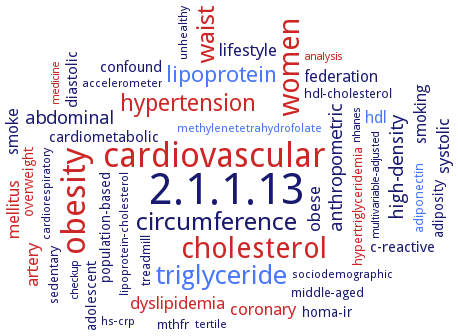2.1.1.13: methionine synthase
This is an abbreviated version!
For detailed information about methionine synthase, go to the full flat file.

Word Map on EC 2.1.1.13 
-
2.1.1.13
-
cardiovascular
-
obesity
-
cholesterol
-
women
-
triglyceride
-
circumference
-
waist
-
hypertension
-
lipoprotein
-
high-density
-
anthropometric
-
abdominal
-
obese
-
coronary
-
artery
-
mellitus
-
lifestyle
-
dyslipidemia
-
systolic
-
hdl
-
smoking
-
federation
-
smoke
-
cardiometabolic
-
c-reactive
-
diastolic
-
confound
-
population-based
-
adolescent
-
overweight
-
homa-ir
-
adiposity
-
adiponectin
-
sedentary
-
mthfr
-
middle-aged
-
hdl-cholesterol
-
hypertriglyceridemia
-
treadmill
-
cardiorespiratory
-
lipoprotein-cholesterol
-
unhealthy
-
methylenetetrahydrofolate
-
hs-crp
-
tertile
-
sociodemographic
-
accelerometer
-
nhanes
-
analysis
-
multivariable-adjusted
-
medicine
-
checkup
- 2.1.1.13
- cardiovascular
- obesity
- cholesterol
- women
- triglyceride
-
circumference
- waist
- hypertension
- lipoprotein
-
high-density
-
anthropometric
- abdominal
-
obese
- coronary
- artery
- mellitus
-
lifestyle
- dyslipidemia
-
systolic
- hdl
-
smoking
-
federation
-
smoke
-
cardiometabolic
-
c-reactive
-
diastolic
-
confound
-
population-based
-
adolescent
- overweight
-
homa-ir
-
adiposity
- adiponectin
-
sedentary
- mthfr
-
middle-aged
-
hdl-cholesterol
- hypertriglyceridemia
-
treadmill
-
cardiorespiratory
-
lipoprotein-cholesterol
-
unhealthy
- methylenetetrahydrofolate
-
hs-crp
-
tertile
-
sociodemographic
-
accelerometer
-
nhanes
- analysis
-
multivariable-adjusted
- medicine
-
checkup
Reaction
Synonyms
5-methyltetrahydrofolate homocysteine methyltransferase, 5-methyltetrahydrofolate-homocysteine methyltransferase, 5-methyltetrahydrofolate-homocysteine S-methyltransferase, 5-methyltetrahydrofolate-homocysteine transmethylase, B12 N5-methyltetrahydrofolate homocysteine methyltransferase, B12-dependent methionine synthase, cobalamin-dependent methionine synthase, folate-dependent methionine synthase, Met6p, MetH, methionine synthase, methionine synthetase, methyltetrahydrofolate-homocysteine vitamin B12 methyltransferase, methyltransferase, methyltetrahydrofolate-homocysteine, MetS, MS, MS1, MTR, N-methyltetrahydrofolate:L-homocysteine methyltransferase, N5-methyltetrahydrofolate methyltransferase, N5-methyltetrahydrofolate-homocysteine cobalamin methyltransferase, N5-methyltetrahydrofolic-homocysteine vitamin B12 transmethylase, tetrahydrofolate methyltransferase, tetrahydropteroylglutamate methyltransferase, tetrahydropteroylglutamic methyltransferase, vitamin B12 methyltransferase


 results (
results ( results (
results ( top
top





